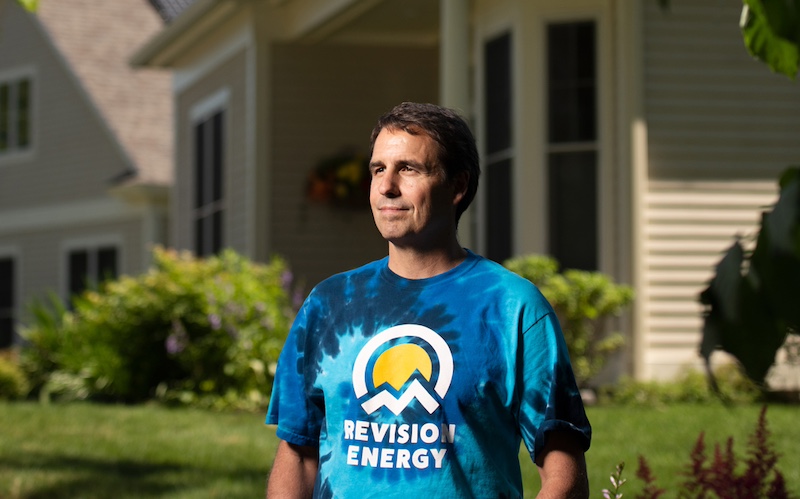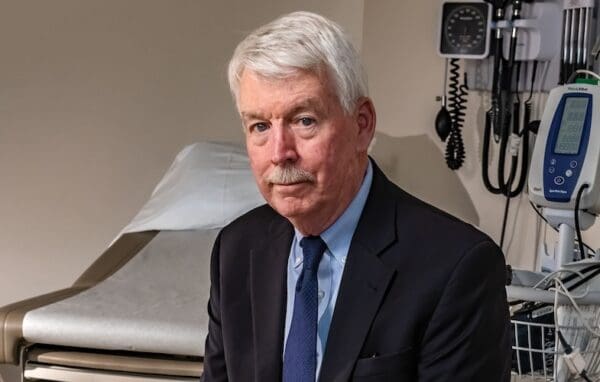
Phil Coupe is the co-founder of ReVision Energy. Photo: Brian Fitzgerald/fitzgeraldphoto.com
For the past 20 years, Phil Coupe has worked in clean energy. He’s witnessed technologies that once seemed like a sci-fi plot twist—electric planes and solar-powered steel plants—move from fantastical ideas to reality. And the irony, says Coupe, is that many of us aren’t even aware of it. That’s why Coupe, co-founder of ReVision Energy, a solar company active in Maine, New Hampshire, and Massachusetts, wants to get the word out. Coupe, a member of CLF’s board, recently visited CLF’s Boston office, where his optimism on our national and global transition toward renewable energy nearly outshone the sun.
Below, we’ve adapted his remarks for length and clarity into an abridged Q and A.
CLF: We’ve made some huge strides in renewable energy in the last decade, with renewables representing about 25% of the energy generated in the U.S. in the first half of last year. Still, we’re not where we need to be. What’s slowing the transition to clean energy down?
Coupe: First is the deeply embedded culture of convenience created by fossil fuels, which makes people anxious about maintaining their lifestyle without oil and gas. Second, internal combustion engine exhaust technology renders greenhouse gas emissions mostly intangible. That lulls people into a false sense of security because we can’t see the vast air pollution we emit into the atmosphere. The third obstacle, perhaps the most challenging of all, is that over the past 50 years, the fossil fuel industry has metastasized into a multitrillion-dollar colossus using its unrivaled financial and political power to stop the energy transition at all costs.
Relentless disinformation campaigns by the fossil fuel industry have spread doubt, chaos, and confusion in the minds of consumers about clean energy, about climate change, and about whether an energy transition is necessary or even possible.
CLF: So what’s the truth that New Englanders should know about renewable energy, particularly solar energy?
Coupe: In one hour, the sun delivers enough energy to the surface of the Earth to power global energy demand for an entire year. Consider the solar resources in northern New England, where many people instinctively believe we’re too far north and it’s too cold for solar panels to be effective. In fact, our latitude is similar to Monaco on the French Riviera, a famously sunny region in southern France and northern Spain. A rooftop solar array in Boston will yield roughly the same amount of solar electricity per year as an array in Houston, Texas. This is because solar electric panels are much more efficient at lower temperatures, meaning New England’s arrays deliver maximum yield on a day when it’s sunny and cold.
CLF: But what about the costs?
Coupe: The cost of solar panels has dropped by more than 90% over the last 20 years, making solar electricity the cheapest energy ever known to humankind.
This means that the life cycle costs of a solar array are about a third cheaper than the life cycle costs of coal, oil, and gas when you factor in the cost of extraction, transportation, refining, and distribution of fossil fuels. This is a big reason U.S. solar installations have increased one thousand-fold over the last 20 years.
CLF: We know we can generate all the energy we need from the wind and sun. But how do we solve the problem of generating energy when the sun isn’t shining, or the wind isn’t blowing?
Coupe: Battery storage is the answer. And just like solar energy, the costs of this relatively clean technology are starting to plunge. Because the climate crisis and clean energy economic opportunities are so enormous, scientists and entrepreneurs are innovating new ways to store abundant wind and solar energy to fill the gaps caused by weather and nighttime.
Already, we are seeing cobalt-dependent lithium-ion batteries gradually being replaced by lithium-phosphate batteries, reducing the grave social and environmental impacts of cobalt mining. Local companies like Somerville, Massachusetts-based Form Energy are pioneering new technologies like massive iron-air batteries that can provide utility-scale multi-megawatt storage for up to 100 hours. Form Energy has already begun construction of its first manufacturing plant in West Virginia thanks to the incentives of the Inflation Reduction Act.
This type of large-scale storage will be crucial for decarbonizing energy-hungry cities like Boston and New York.
CLF: You’ve mentioned several clean energy initiatives taken on by larger and smaller companies, including Irving Oil, which installed electric charging pumps and solar arrays at its gas stations, and Target, which built a store that generates 100% of its electricity needs with rooftop solar and solar parking canopies. You’ve also mentioned electric planes, tugboats, container ships, cruise ships, and a steel mill run by a 300-megawatt solar array. But what about progress in how our homes are powered?
Coupe: Ten years ago, at ReVision Energy, we had a vision of a cost-effective 100% solar household. But solar panels were still too expensive, and electric cars, heat pumps, and battery storage were not ready for prime time. But if we fast forward by just a decade, I’m happy to report that we are converting multiple homes per week to 100% solar, plus clean technology. One house we worked with in New Hampshire has solar on the roof, an electric car in the driveway, heat pump ductwork, and battery storage in the basement. This home went from burning 600 gallons of propane annually to less than 25 gallons per year. And the homeowner is making out like a bandit because the system costs for clean energy have dropped so steeply. The technology has progressed to the point where the clean energy economics blow the old way of doing things away.
With the technology available today, we could essentially eliminate fossil fuels in the entire residential sector through solar electricity, battery storage, electric heat pumps, and maybe an electric vehicle for transportation.
We have the tools that we need to abandon fossil fuels!
This is one in an occasional series on New England’s energy innovators.



